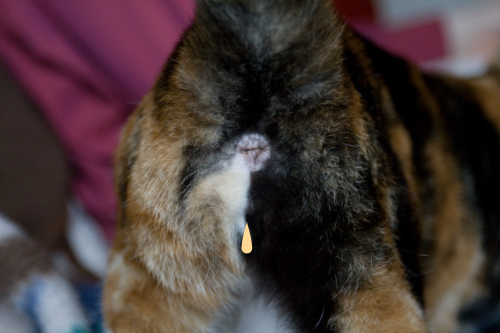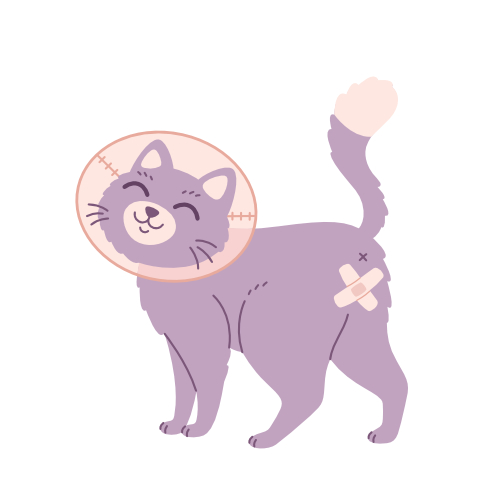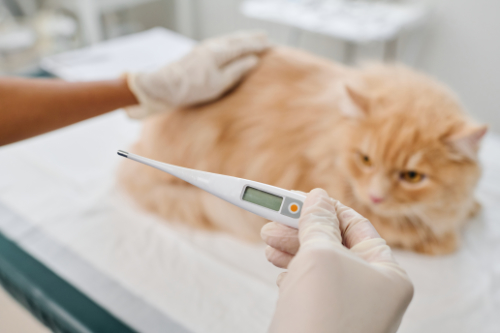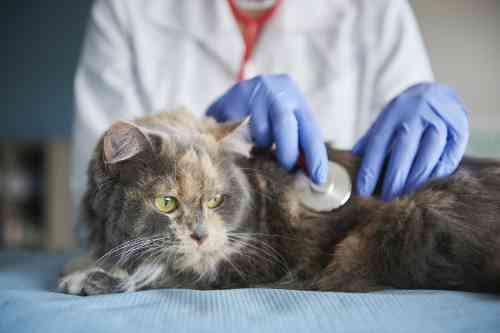Vaginal discharge in a cat
How does that happen?
In this article we discuss the causes and possible consequences of vaginal discharge in cats. What other symptoms can you see besides vaginal discharge and what can you do about the discharge? Can you actually do something yourself if your cat has discharge from her vagina? Find out in the following text! In this text we do not discuss bloody urine that is coming out of your cat’s vulva. More about bloody urine in a cat issue you can read here.
Do cats also get their periods like humans?
No, cats don’t get their periods the way we humans do. The reproductive cycle of the uterus of a cat is different from that of a human. As a result, cats do not have menstruation like we humans do or a heat cycle like dogs have.
What causes vaginal discharge in a cat?
Vaginal discharge in a cat can be caused by hormonal activity such as during her heat. But it can also indicate inflammation. In that case it might be a uterine infection or a vaginal infection.
The first is also called pyometra with a difficult word. Pyo stands for pus and metra refers to the uterus. In other words: a purulent uterus. In that case, the uterus is full of pus cells because a bacterial infection has entered her uterus. Her body tries to solve it by sending pus cells there. This causes her uterus to become filled with pus. It goes without saying that this can only occur in a cat that has not yet been neutered.
In the second case, vaginal inflammation, we call it vaginitis. If you see -itis stuck behind a word somewhere, it is an inflammation of that part. So in this case vaginitis is an inflammation of the vagina. It is quite rare in a cat. If it is seen at all, an object has often entered the vagina, such as a piece of grass or there is a polyp. There is almost always a bacterial infection in the vagina.
But hasn’t your cat been neutered and you suddenly see vaginal discharge in a cat coming from her vagina? Then it is also possible that she is pregnant and you did not notice it. At the end of pregnancy, when they start giving birth, they may also experience vaginal discharge.
What symptoms does a cat have with vaginal discharge?
You do not always have to see additional symptoms besides vaginal discharge in a cat. It is possible that you may also see the following symptoms. Check and observe your cat a little extra carefully.
- being generally unfit
- stomach ache
- eat less
- feeling warm / having a fever
- drinking and urinating more than she normally does
- vomiting
- swollen abdomen
- a lot of vulva licking
- very occasionally pain when urinating
Is vaginal discharge in your cat dangerous?
If your cat has a uterine infection, this can unfortunately be fatal for her. If a tear occurs in her uterus, the pus, together with the bacteria, will flow into her abdominal cavity. There the bacteria infect the other organs and the peritoneum. In that case, things usually don’t end well for your cat within a few days.
If your cat was not neutered, she could of course also be pregnant. If she has vaginal discharge, she is already a bit further along in her pregnancy and then, with some effort, you should be able to feel kittens in her belly. Feel carefully! Because you don’t want to damage the kittens, but you also don’t want to cause a possible uterine infection to rupture in her abdomen.
However, if your cat has been neutered, it is not life-threatening. In that case, there will probably be vaginitis, or vaginal inflammation.
How do you make a diagnosis?
What is a uterine infection in your cat?
During a uterine infection, bacteria have entered her uterus. These bacteria started to multiply because it liked a nice warm and moist place. Your cat’s body noticed it and naturally wants to try to get rid of it. It then sends pus cells to it. The pus cells then “eat” those bacteria. Normally, the body then cleans up the pus cells itself. But in this case there are so many bacteria and the body cannot stop the bacterial growth. More and more pus cells keep moving towards the uterus. Until that uterus is completely filled with pus and is under tension.
Eventually the uterus will rupture and the pus will flow into the abdominal cavity together with the bacteria. There it will inflame the rest of the body and your cat will die within a few days.
Fortunately, cats often have an “open uterine infection”. This means that the pus can also be removed through the vagina. In that case it takes longer before the uterus ruptures. Your cat’s chances increase considerably. And since you ended up on this page because you saw vaginal discharge in your cat, there is a good chance that your cat has an open uterine infection, if she is not pregnant.
Risk of uterine infection in cats
According to a Swedish study conducted among cats with pet insurance, it emerged that some breeds have an increased risk of developing a uterine infection. The Norwegian forest cat and the Siamese in particular are more likely to develop a uterine infection.
On avarage in all cats a uterine infection happens in about 2,2%. In the Norwegian Forrest cats it happens in 14,8% of the cats. In Sacret Birmans it is 3,1%. The persian cats are good for 3,4%, Siamese 8,5% and European shorthair only 0,9%.
What can you do about vaginal discharge in your cat?
You can of course clean your cat’s vagina thoroughly. Only if your cat has been neutered can you use the disinfectant wipes below.
If your cat has not been neutered, she is either pregnant or has a uterine infection. In that case it is wiser to go to your vet.
When should you take your cat to the vet if she has vaginal discharge?
If your cat has not been neutered and you see vaginal discharge in a cat, it is always best to take your cat to your vet. He or she can then investigate whether she is pregnant or whether she has a uterine infection. In some (doubtful) cases they will have to make an ultrasound for this. Do you no longer want to have a litter and is your cat not far in her pregnancy? Then it is better to have her neutered immediately. In many cases, the costs for an ultrasound are approximately comparable to the operation of the neutering.
If your cat has been neutered in the past, you can first try whether cleaning the vagina with the chlorhexidine disinfectant wipes is sufficient. However, she may not have any other symptoms. So she needs to eat well and drink normally. And she must not appear sick. If in doubt, it is better to go to your own vet.
What does your vet do about a uterine infection?
- If your cat has a uterine infection and as a result has vaginal discharge, the wisest choice is to have your cat neutered. In that case, your vet will remove her ovaries, but also her entire uterus.
- In the days after the operation, your cat will receive a course of antibiotics and a painkiller/anti-inflammatory
- If your cat has been very ill, she may need to stay with your vet for a few days. In that case, she often receives an IV so that her body is thoroughly flushed. The whole body had to fight very hard. Her kidneys in particular are affected and therefore need some support with the IV.
- Your cat also often wears a medical pet shirt to ensure that she does not lick her abdominal wound. After all, this wound is somewhat larger than after a “normal” neutering operation.
But what if you wanted to have another litter with your cat?
In principle, most veterinarians advise to opt for neutering anyway. Your cat’s life is currently more valuable than the lives of future kittens. However, is neutering something you really don’t like? And you really thought about it carefully? Then there are options available.
Your cat can be admitted to the vet and given an IV. They can administer an anesthetic through this IV every day so that your cat can “sleep” for a short while. While she is sleeping, your vet can use a small tube through the vagina to her uterus. A cat will not allow this when she is awake. They then rinse the uterus with an aqueous solution through that tube. It often also contains an antibiotic. This way, as many pus cells as possible, but more importantly, as many bacteria as possible are removed. In addition, your cat will be injected with a drug that causes the uterus to contract so that as much junk as possible is squeezed out. And of course your cat will receive strong painkillers and a course of antibiotics during the period that she is admitted.
As soon as no more pus is removed from the uterus during flushing, it is time for your cat to return home and continue to recover. In the meantime, she must of course not deteriorate, otherwise she will still have to opt for surgical removal of her uterus.
How can you prevent vaginal discharge in your cat?
Having your cat neutered at a young age greatly reduces the chance of vaginal discharge in a cat. Do not opt for the cat variant of the birth controll pill if you no longer want to have a litter because this actually increases the risk of developing a uterine infection.
Hopefully your cat recovers of her vaginal discharge very soon. Good luck!






